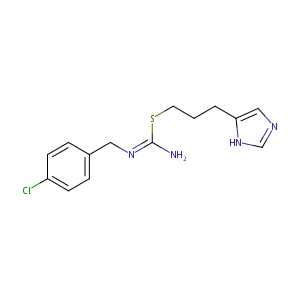Details of the Drug
General Information of Drug (ID: DM537OH)
| Drug Name |
Clobenpropit
|
||||||||||||||||||||||
|---|---|---|---|---|---|---|---|---|---|---|---|---|---|---|---|---|---|---|---|---|---|---|---|
| Synonyms |
clobenpropit; 145231-45-4; Vuf-9153; Vuf 9153; UNII-RKU631JF4H; S-(3-(4(5)-Imidazolyl))propyl-N-(4-chlorobenzyl)isothiourea; CHEBI:64177; RKU631JF4H; 3-(1h-imidazol-5-yl)propyl n'-(4-chlorobenzyl)carbamimidothioate; 3-(1H-imidazol-4-yl)propyl ((4-chlorophenyl)methyl)carbamimidothioate; Carbamimidothioic acid, ((4-chlorophenyl)methyl)-, 3-(1H-imidazol-4-yl)propyl ester; 3-(1H-imidazol-4-yl)propyl N-(4-chlorobenzyl)carbamimidothioate; Carbamimidothioic acid,N-[(4-chlorophenyl)methyl]-, 3-(1H-imidazol-5-yl)propyl ester
|
||||||||||||||||||||||
| Indication |
|
||||||||||||||||||||||
| Drug Type |
Small molecular drug
|
||||||||||||||||||||||
| Structure |
 |
||||||||||||||||||||||
| 3D MOL | 2D MOL | ||||||||||||||||||||||
| #Ro5 Violations (Lipinski): 0 | Molecular Weight (mw) | 308.8 | |||||||||||||||||||||
| Logarithm of the Partition Coefficient (xlogp) | 3 | ||||||||||||||||||||||
| Rotatable Bond Count (rotbonds) | 7 | ||||||||||||||||||||||
| Hydrogen Bond Donor Count (hbonddonor) | 2 | ||||||||||||||||||||||
| Hydrogen Bond Acceptor Count (hbondacc) | 3 | ||||||||||||||||||||||
| Chemical Identifiers |
|
||||||||||||||||||||||
| Cross-matching ID | |||||||||||||||||||||||
Molecular Interaction Atlas of This Drug
 Drug Therapeutic Target (DTT) |
|
|||||||||||||||||||||||||||||||||||||||||||||||||||
|---|---|---|---|---|---|---|---|---|---|---|---|---|---|---|---|---|---|---|---|---|---|---|---|---|---|---|---|---|---|---|---|---|---|---|---|---|---|---|---|---|---|---|---|---|---|---|---|---|---|---|---|---|
 Drug Off-Target (DOT) |
|
|||||||||||||||||||||||||||||||||||||||||||||||||||
| Molecular Interaction Atlas (MIA) | ||||||||||||||||||||||||||||||||||||||||||||||||||||
Molecular Expression Atlas of This Drug
| The Studied Disease | Discovery agent | |||||||||||||||||||||||
|---|---|---|---|---|---|---|---|---|---|---|---|---|---|---|---|---|---|---|---|---|---|---|---|---|
| ICD Disease Classification | N.A. | |||||||||||||||||||||||
|
||||||||||||||||||||||||
| Molecular Expression Atlas (MEA) | ||||||||||||||||||||||||
References
